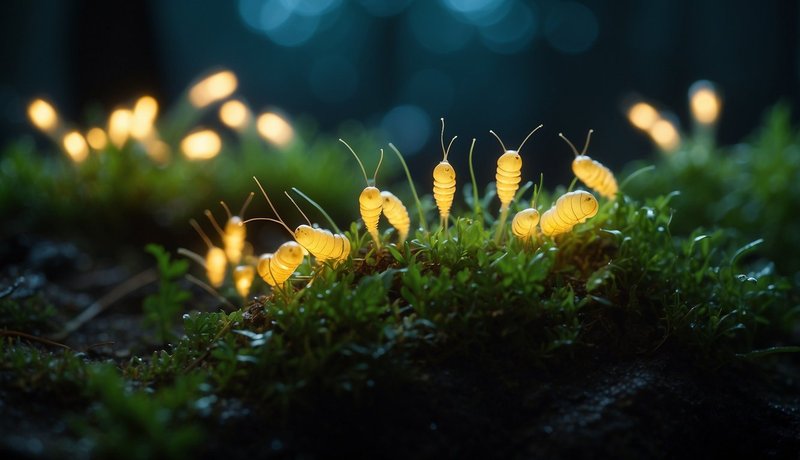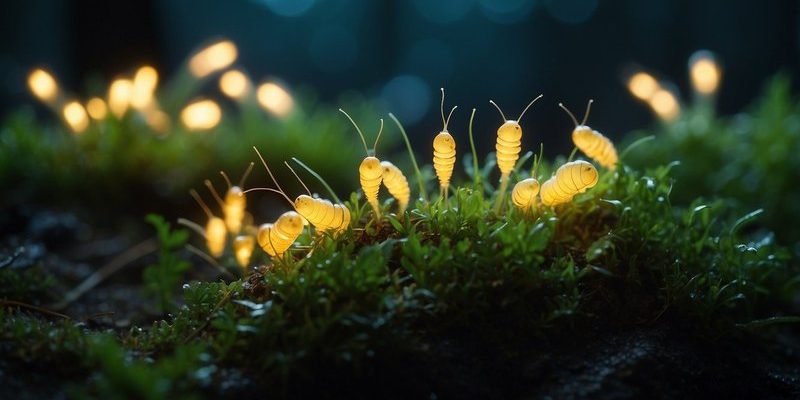
You might be wondering how these tiny beings fit into the grand story of the forest. Think of glow worms as the night’s little stars, illuminating the underworld of the woods. They serve essential functions, from aiding in nutrient cycling to attracting mates and assisting in pest control. Grab a cup of coffee, and let’s explore the fascinating world of glow worms and their impact on forest ecosystems.
What Are Glow Worms?
Glow worms are not actually worms; they’re the larvae of various beetle species, mainly from the Lampyridae family. While their adult forms can be elusive and often fly, it’s the larvae that capture our attention with their bioluminescence. You might think of them as nature’s fairy lights, glowing a soft blue or green in the dark. This light comes from a chemical reaction within their bodies, allowing them to glow brightly in the forest’s shadows.
The light serves a crucial purpose: it’s an attractive lure for unsuspecting insects. The glow worms exude a sticky silk thread that captures their prey, ensuring they have enough food to grow and eventually emerge as adults. So, while they may look delicate and ethereal, they are skilled hunters within their forest domain.
The Importance of Glow Worms in Nutrient Cycling
One of the most important roles glow worms play in forest ecosystems is their contribution to nutrient cycling. As they consume insects and organic matter, they break down these materials, returning vital nutrients back to the soil. This natural process helps enrich the forest floor, promoting plant growth and supporting the entire ecosystem.
You might ask, how does this cycle work? Well, it’s quite simple. When glow worms digest their food, they process it into waste that is rich in nutrients. This waste is then left behind in the soil, where it becomes food for microorganisms and plants. Without glow worms, these nutrients would be locked away in dead organic matter, unavailable for the living plants that depend on them.
Glow Worms and Pest Control
Another fascinating aspect of glow worms is their natural ability to help with pest control. By preying on various insects, they naturally keep populations in check. Imagine them as tiny forest guardians, maintaining a balance among the insect community.
Why is this important? If insect populations grow too large, they can devastate plants and disrupt the entire ecosystem. Glow worms, by capturing pests, help ensure that the forest remains healthy and vibrant. Their role in controlling pests extends beyond just their immediate vicinity; it contributes to the overall stability of the environment.
Glow Worms as Indicators of Ecosystem Health
Glow worms also serve as excellent bioindicators of forest health. Their presence or absence can tell us a lot about the quality of the ecosystem. Healthy glow worm populations generally indicate a thriving environment with minimal pollution and sufficient food resources.
Here’s the thing: if researchers notice a decline in glow worm numbers, it’s often a warning sign that something is off in the ecosystem. This prompts further investigation into potential issues, such as habitat destruction, pollution, or climate change. By keeping an eye on these fascinating insects, we can gain insights into the overall health of our forests and take steps to protect them.
The Cultural Significance of Glow Worms
Beyond their ecological roles, glow worms have captured the imaginations of humans for centuries. Many cultures celebrate them in stories and art, often associating their light with hope and guidance. For instance, in Maori culture, glow worms are seen as a symbol of the spirits guiding travelers through the darkness.
Moreover, eco-tourism has begun to highlight areas where glow worms thrive, drawing visitors eager to witness their enchanting light shows. Places like New Zealand proudly showcase glow worm caves, turning them into popular tourist attractions. This not only raises awareness about these unique creatures but also promotes conservation efforts to protect their habitats.
How Glow Worms Adapt to Their Environment
Glow worms have evolved unique adaptations that allow them to thrive in their forest habitats. For one, they prefer moist, dark environments, often found in damp soil, rotting wood, or cave systems. This preference helps keep them safe from predators while providing ample food sources.
Additionally, their bioluminescence is a fascinating adaptation. The glow serves both to attract prey and to deter some potential predators. The light makes it harder for certain animals to see them clearly, increasing their chances of survival. Isn’t nature clever?
Another interesting fact is that glow worms can adjust their light output based on environmental conditions, such as humidity or temperature. This adaptability is crucial for their survival, allowing them to thrive in varying forest conditions.
Conservation Efforts for Glow Worms
As enchanting as glow worms are, they face significant threats from habitat loss, pollution, and climate change. Conservation efforts are crucial to ensure that future generations can enjoy their sparkling presence.
Various organizations are working to protect their habitats by promoting sustainable forestry practices and reducing chemical use in agriculture. You can help, too—simple actions like reducing plastic waste and supporting conservation programs can make a big difference.
Creating awareness about glow worms is equally important. By sharing their story and promoting eco-friendly tourism, we can inspire others to appreciate and protect these unique creatures. Every small effort counts in the grand tapestry of our forest ecosystems.
In conclusion, glow worms are more than just magical lights in the forest; they are vital players in the ecological drama that unfolds in our woodlands. From nutrient cycling to pest control and serving as indicators of ecosystem health, their roles are invaluable. As we celebrate their beauty and significance, let’s be inspired to protect the enchanting worlds they inhabit. After all, preserving our forests means preserving the glow of these wonderful creatures for generations to come.

